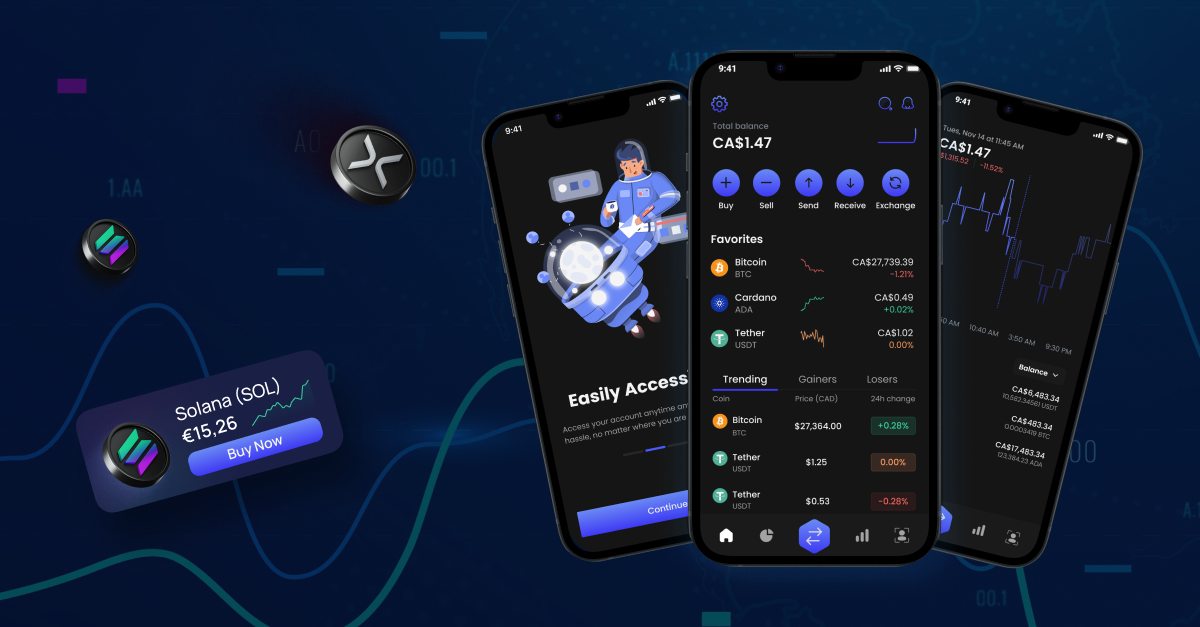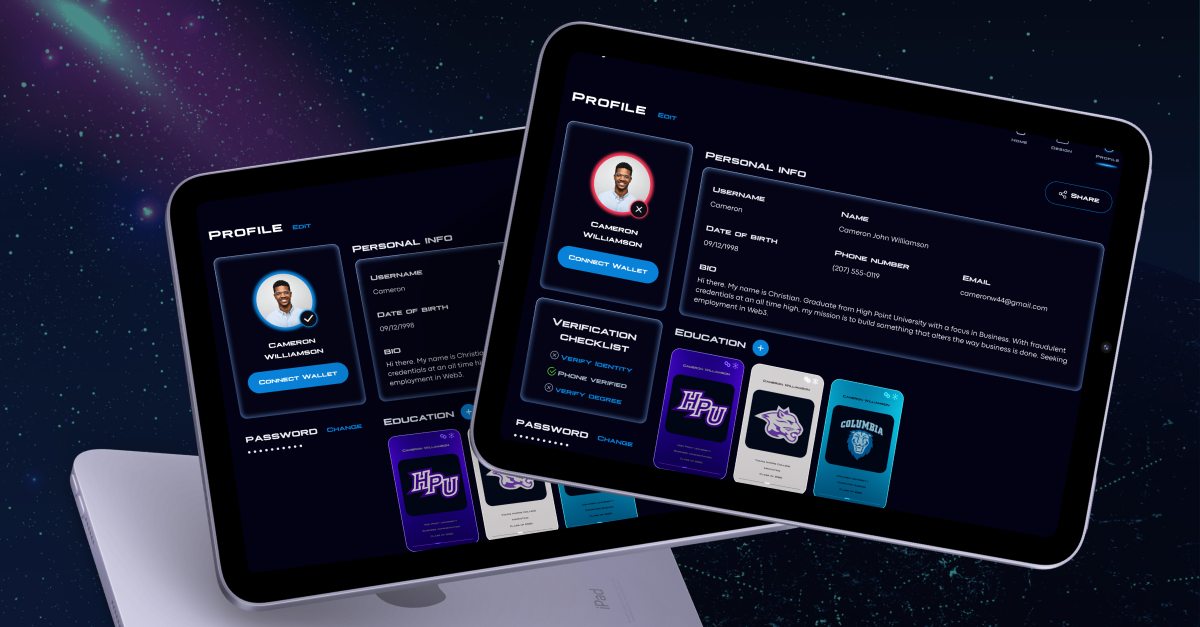Cryptocurrency is a buzzword in the modern world. Being one of the most popular digital currencies that is said to replace dollars, people use these assets to buy goods and services. Cryptocurrency is a popular choice for many companies and customers as it ensures a high-security level working on blockchain ledger used to secure all online transactions. Immense interest in these unregulated currencies results from people’s desire to gain profit without working.
According to the most well-known marketplace, over 65% of cryptocurrency users own bitcoins. This is the pioneer in the blockchain ecosystem and is now one of the most popular digital currencies. We carefully curated this guide to help any company enter the industry and grow revenue. Here you can find easy steps and tips on how to create your own cryptocurrency and blockchain architecture from scratch. Hire blockchain developers and grow your business alongside market size.
Even though cryptocurrency is now used as a new form of payment that can be exchanged online for services, goods, or even for paying salary somewhere, there is a great space for companies to enter the industry with their brand-new ideas. In this highly digital world, time is an essential factor as the market situation changes quickly due to high market volatility and COVID-19 impact.
Key Statistics
The worldwide blockchain market is estimated to grow to $1,43 billion by 2030.
The global blockchain market will grow at a CAGR of 80% to 88% throughout the period to 2030.
Bitcoin occupied the largest segment accounting for over 45% of the total revenue.
What is a Cryptocurrency?
This is a digital asset or payment system that doesn’t rely on financial organizations to ensure safe transactions. This is also called a peer-to-peer system that allows anyone from all across the world to send and get payments. Cryptocurrency replaces physical money that is carried in your pocket, as digital payments exist only online and are stored in special digital wallets. The first cryptocurrency, Bitcoin, was introduced to the world in 2009 and remains the leader today.

Are You Ready to Launch Your Cryptocurrency App?
How Does Cryptocurrency Work?
How do you answer the question of how to make a crypto app without understanding its basics? All cryptocurrencies like Bitcoin, Ethereum, Litecoin, and Ripple run on a distributed public ledger known as the blockchain, a system of recording all transactions appearing and held by asset holders.
Cryptocurrency units are created through a process called mining, which requires using computers to resolve tricky mathematical issues when generating coins. However, holders can buy digital coins from specialized brokers that will then be stored and spent via online wallets.
It is vital to mention that you don’t have anything material when you have a cryptocurrency. This is only a key that provides you with an opportunity to move a record or a coin of measure from one to another without unnecessary third parties.

Types of Cryptocurrency Applications
-
Cryptocurrency Wallet
This is one of the most popular types of cryptocurrency software that is designed to store customers’ private and public keys. These applications allow customers to sign needed transactions, track expenses, and keep all passwords within one platform, which is safer and more protected.
-
Statistics Aggregation Platform
Even though there is not much information regarding these types of apps, it is a popular and in-demand software that might be a good choice to enter this market. However, when creating this software, you need to pay high attention to the UI/UX design, plus make sure your product has outstanding functionality needed for collecting data.
-
Cryptocurrency Trading Application
When developing this application, you have a choice: it could be a regular cryptocurrency exchange like well-known Bitstamp, or Kraken, decentralized exchanges like Compound, or peer-to-peer trading platforms such as LocalBitcoins. The development of these applications requires deep expertise, a long time for the development process, and many resources. This is because it is not only a mobile platform, but it also has to contain a corresponding back-end.
-
E-commerce App
It’s like having an online store or exchange platform, and you want to get payments in cryptocurrencies like Bitcoin. However, make sure you hire an experienced blockchain development company as the team will probably need to process each such payment manually because today, there are no stable payment gateways exciting in open source. Even though these projects have already been created several times with little success, an experienced development team can help you achieve market success.
Benefits of Crypto App Development
Decentralization
This is mainly because of the blockchain digital ledger presence in these applications. Its decentralized nature makes cryptocurrency free from regulated power, meaning no one can create rules for cryptocurrencies’ holders.
Unlimited and Fast Transactions
Since companies strive to provide ultimate convenience, cryptocurrency apps will be a great choice for them. While regular processing and settlement of transactions require time and resources, crypto apps allow businesses to make an unlimited number of transactions within minimum time.
Reduced Transaction Fees
As everyone knows, all financial organizations charge significant fees for every transaction. Even though crypto apps do not free you from paying fees, the amount of money is significantly lower.
Open Transparency and Anonymity
Within the blockchain ecosystem, every transaction is recorded and exists in the system, providing open transparency. In addition, in case the crypto address was not publicly confirmed, the transaction remains anonymous.
Key Features of Crypto Apps
-
User Authorization
Considering the popularity and value of digital assets, your application needs to be protected from hackers attacks. This is why this feature is a must-have for any of these applications. We recommend you enhance the authentication of your customers using two-factor or multi-factor authentication (2FA or MFA).
-
QR Code Scanner
Since QR codes are fast, secure, and provide speed, you can add this feature to your app. If you boost the app with a QR code scanner, users will be able to facilitate automatic scanning of the wallet addresses and get their keys. Therefore, it can significantly enhance all transactions within a few clicks.
-
Push Notifications
Like with any other application, push notifications are a crucial feature. Your users can always be informed & notified of everything vital for them happening on the platform. Depending on the information in your product, users have to be notified regarding transactions, new coins, the price of their assets, the success of payments, as well as the failure.
-
Latest Conversion Rates
This is a great feature to add to crypto wallet development. None of these platforms can bring you success without calculating transaction fees according to ever-changing conversion rates.
-
Blockchain Transactions
Since these apps run on blockchain technology, your customers will have an opportunity to transfer and get digital assets via the app you developed following an entirely tamper-proof model.
Additionally, your platform will give users the ability to see the current balance and the whole transaction history due to blockchain transparency.
-
Payment Gateways
If you add a payment gateway into your app, you can give users a chance to buy or sell their digital assets efficiently and fast.
Concept of Cryptocurrency Token
How to create your own cryptocurrency app question is only sufficient with comprehending the essence of digital currency tokens. A token is a digital image of an asset, utility, or identity that can be transferred among users or applications. Tokens frequently aid transactions and exchanges on blockchain networks. Common types of tokens include utility tokens, security tokens, and stablecoins. A cryptocurrency application development utilizes different types of tokens according to business needs.

Types of Tokens
-
Utility Tokens
Utility tokens grant users access to a specific product or service offered by a blockchain-based platform or application. They enable users to perform actions or access features on the platform, and their value is directly linked to their usefulness.
A significant advantage of utility tokens is that they are not intended for investment or to serve as a store of value like standard cryptocurrencies. Tokens facilitate access to services and functions within a particular platform or ecosystem. For instance, a file storage platform may issue tokens that enable users to acquire additional storage space, whereas a gaming platform may issue tokens that customers can use to buy in-game items.
-
Security Tokens
Security tokens are digital assets that imply ownership of an underlying asset like stocks, bonds, real estate, or artwork. They follow similar regulations to traditional securities, adhering to various legal requirements. However, they implement blockchain technology for more efficient and secure ownership management and trading. One major benefit of security tokens is their ability to be traded on decentralized exchanges (DEXs) without intermediaries such as brokers or clearinghouses.
-
Payment Tokens
Payment tokens are a form of cryptocurrency specifically intended for use as a means of exchange. These tokens enable users to make and receive payments on a blockchain network. They are often called “stablecoins” due to their typical pegging to a real-world currency, like the US dollar or Euro, to maintain price stability.
One of the primary benefits of payment tokens is their potential to decrease volatility and uncertainty in the cryptocurrency market by serving as a stable source of value backed by real-world assets.
-
Non-Fungible Tokens (NFTs)
Non-fungible tokens (NFTs) are digital assets that exhibit ownership of exclusive items like art, music, collectibles, and even real estate. The term “non-fungible” implies that each token is one-of-a-kind and can’t be substituted by another identical token. This differs from fungible tokens, like Bitcoin, where every unit is interchangeable and holds the same value as any other unit.
One of the primary advantages of NFTs is their ability to help creators monetize their work and receive just compensation for their efforts. Since each NFT is one-of-a-kind and can only be owned by one person at a time, they offer artists, musicians, and other creators a means of establishing provenance and authenticity for their digital creations.
-
Governance Tokens
Governance tokens incentivize participation in a DAO’s governance and reward active members who contribute to the organization’s success. Members can earn tokens by contributing to the community, such as participating in discussions, submitting proposals, and voting on important decisions.
The weight of each vote is proportional to the number of tokens the voter holds, so those with more tokens have greater decision-making power. This ensures that the most engaged and dedicated community members have a greater influence in guiding the organization’s course.
-
Privacy Tokens
Privacy tokens are a type of cryptocurrency designed to protect their users’ privacy in several ways. Firstly, they often use advanced cryptographic techniques to encrypt user data and ensure that transactions are secure and private. Secondly, they may employ zero-knowledge proofs, which helps users to prove that they have certain information without revealing it.
A popular example of a privacy token is Monero, which uses advanced cryptographic techniques to protect user privacy. Monero uses ring signatures, which allow users to sign transactions without revealing their identity. This ensures that all transactions are anonymous and can`t be traced back to the original user.
Utility tokens grant users access to a specific product or service offered by a blockchain-based platform or application. They enable users to perform actions or access features on the platform, and their value is directly linked to their usefulness.
A significant advantage of utility tokens is that they are not intended for investment or to serve as a store of value like standard cryptocurrencies. Tokens facilitate access to services and functions within a particular platform or ecosystem. For instance, a file storage platform may issue tokens that enable users to acquire additional storage space, whereas a gaming platform may issue tokens that customers can use to buy in-game items.
How to Create a Cryptocurrency Token?
-
1. Define the Purpose and Functionality
The tokenomics of the token needs to be developed, including how it will be distributed among holders (ICO, airdrop, etc.) and in what period (vesting, cliff, etc.).
-
2. Choose a Blockchain Platform
You can use an established blockchain platform, such as EVM-compatible blockchains like Polygon Avalanche, or L-2 solutions like Arbitrum and Optimism, to produce your token or construct your blockchain from scratch. Many individuals prefer to employ an existing blockchain since it is simpler and more financially efficient.
-
3. Create a Smart Contract
A smart contract is an autonomous code that establishes the protocols and guidelines for your cryptocurrency tokens. It enables the automation of token purchasing, selling, and trading on the blockchain network. Use OpenZeppelin ERC-20 standard form, which contains basic token functionality. There, you need to choose “name,” “symbol,” and “totalSupply” (how many tokens should be in the circulation of the token.
Here is a basic ERC-20 token code snippet:
// SPDX-License-Identifier: MIT
pragma solidity ^0.8.0;
import “@openzeppelin/contracts/token/ERC20/ERC20.sol”;
contract TestToken is ERC20 {
constructor(uint256 initialSupply) ERC20(“TestName”, “TST”) {
_mint(msg.sender, initialSupply);
}
} -
4. Test the Smart Contract
It’s crucial to test smart contracts to ensure they function properly. You can leverage test networks such as Goerli as an Ethereum testnet or Mumbai for Polygon before launching on the mainnet. If you need to test ETH for deployment, use a faucet in Goerli.
-
5. Deploy the Smart Contract
The deployment on the mainnet will make your token operational on the blockchain network, enabling individuals to purchase and trade it.
For deployment, testing, and development use one of the following frameworks:
-
6. Add Liquidity
One way to boost liquidity is by listing it on decentralized exchanges such as Uniswap or PancakeSwap. To achieve this goal, you must offer liquidity in your token and another commonly used cryptocurrency like ETH or BNB.
-
7. Market Your Token
It is essential to market tokens effectively to attract both investors and users. This entails creating a website, social media pages, and other marketing materials to promote your token. Connecting with the cryptocurrency community is important to establish confidence and familiarity with your token.
Concept of Cryptocurrency Coin
We finished with how to create a cryptocurrency token, and now it is time to find out what the coin is. A cryptocurrency coin is a digital currency that functions independently of traditional financial institutions. It is crafted using blockchain technology and is decentralized, signifying that no central authority, such as a government or bank, governs it. Coins are frequently employed to stock value, exchange goods or services, or as a unit of measure in diverse blockchain networks.

Coins differ from tokens in that they operate on their dedicated blockchain rather than being created on top of another blockchain. For instance, Bitcoin is a coin that operates on its blockchain, while ERC-20 tokens are created on top of the Ethereum blockchain. So, if you wonder how much it costs to create your cryptocurrency, the development of coins is around $5,000, but building a blockchain for it is substantially more expensive, ranging from $40,000 to $200,000.
Cryptocurrency coins are often mined using computer algorithms, and the underlying blockchain protocol usually limits the number of coins that can be mined. Some popular examples of coins are Bitcoin, Litecoin, and Monero.
How to Create a Cryptocurrency Coin
1. Determine the Purpose and Functionality
Same as with tokens, the tokenomics of the coin should be developed in terms of how it will be distributed among holders, emissions management, supply limitation, etc.
2. Choose a Consensus Mechanism
The consensus mechanism is how transactions on the blockchain are verified and added to the ledger. There are several consensus mechanisms to choose from, including Proof of Work (PoW), Proof of Stake (PoS), Delegated Proof of Stake (DPoS), and others. Choose the one that best fits the needs of your coin.
3. Build a Blockchain Network
A blockchain network is required to support coins. You can build your blockchain network from scratch or use an existing one like Bitcoin, Ethereum, Litecoin, or other cryptocurrencies that allow building coins on top of them.
4. Develop a Mining Algorithm
If you use PoW as your consensus mechanism, you must develop a mining algorithm to reward miners for verifying transactions and adding them to the blockchain. The mining algorithm determines the difficulty level of mining and how often new coins are created.
5. Create a Genesis Block
A genesis block is the first block in a blockchain network. It contains the initial parameters and settings for the network, such as the number of coins in circulation, the mining reward, and the starting difficulty level for mining.
6. Launching
This involves deploying the blockchain network, activating the mining algorithm, and allowing people to start mining and transacting with your coin.
7. Build Community Support
To ensure the success of your cryptocurrency coin, you need to build community support. It is necessary to attract the community to test the network, as part of an ambassadors program, for example, or to make an airdrop for the community afterward.
Step-by-step Development of Cryptocurrency App
1. Understand Blockchain and Cryptos
To answer the question, how to make a cryptocurrency app you should get in touch with several areas. Since blockchain plays a crucial role in crypto app development, you have first to analyze this industry and understand the basics of all these terms.
However, it is always better to hire a full-stack tech company experienced in this space to allow you to reduce the time needed for understanding and avoid mistakes.

2. Find Cryptocurrency Open-source Libraries
Most cryptocurrency libraries are open source, meaning you don’t have to craft everything by yourself. Check the websites like BitcoinJ SDK or Coinbase SDK to find the required tools and resources for your future product.
The biggest advantage of these libraries is that they support the most popular languages like Python, Java, Ruby, etc. Some also work with C ++ and JavaScript languages, so you will find the best that suits your development goals.
3. Apply APIs
API is a distributed ledger API that will help you build a feature-rich platform. APIs help the development team to easily synchronize the crypto wallet with the blockchain ecosystem.
4. Choose the Right Tech Stack
As well as when choosing the team for your project, you will also need to understand what tech stack you need to give your product the needed success. For instance, if you are looking to create a web app, you will need a team developing on Node.js or Angular.js, along with HTML5 version and CSS3. In case you decide to build a native app, you will need Java or Kotlin for Android, or Swift or Objective-C can be used for iOS.
5. Enhanced Security
Security is essential when you create a crypto wallet app. Thi Is why you need to pay close attention to this factor when crafting this software. Depending on your resources, you can either add an extra security layer to the product using 2FA, fingerprint, face ID, or hardware authentication.

6. Analyze Your Competitors
Even though this stage is usually completed at the first step of the development process, here, you can analyze your market and identify what features make your app stand out in the crowd.
7. Start Your UX/UI Design and App Development
Once you have a team of experienced designers and developers while also creating a list of features, start your development. Remember that the design should also be appealing and suitable for customers. It is vital to have an attractive design mockup before beginning the development. Then, create your first MVP and let users review it and understand the pain points. When it is done, create the whole software and send it for testing.
Types of Crypto App Monetization
Promotions
Freemium Model
Affiliate Marketing
Transaction Fees
Paid Applications
Promotions
This is a great monetization method where you will be paid for displaying third-party ads in the apps. The type of this promotion can be divided into several formats, where the most popular ones are ads, video ads, text ads, banners, and interactive ads.
Freemium Model
You should consider the freemium monetization model if you want to update your product and get income regardless of advertising. This is when you have an application with basic functions that can be downloaded for free, but then you suggest customers get a premium version with higher functionality that will be purchased.
Affiliate Marketing
This marketing model places ads in your application and gets revenue every time people reach out to potential clients and/or buy something from their services or products.
Transaction Fees
This quite popular monetization method in crypto apps option means that you will charge a fee for every transaction that appears on your platform.
Paid Applications
Finally, the last and one of the most used methods are paid apps. Unlike the freemium model, users will not get access to your app until they buy it, so the more users you have, the more purchases you get every time.
Why Choose Interexy as a Crypto App Development Company?
Interexy prides itself with outstanding experience in custom blockchain app development. We provide various services for any idea, customizing applications according to your unique needs and requirements.
We’ve been working on various crypto projects, offering clients the best crypto applications, exchange platforms, digital wallets, and even NFT marketing services to ensure market success.
Therefore, when hiring our team, you get a full team of Project Managers, Business Analysts, developers, designers, and QAs already experienced in this challenging field. Our core values are transparency, speed, and quality, meaning you will always know the latest updates get your project on time without compromising features and any minor details you want to see in the final product.
The Bottom Line
Now we have answered how to create your own cryptocurrency app. Considering the popularity of crypto globally and understanding its benefits for any business, the demand and success of this industry can be clearly seen now. Cryptocurrency applications can bring immense opportunities for both businesses and customers who want to enter the space with a trusted provider. Although the market is full of competitors, it is growing every day and has a lot of pain points you can cover with your product. In order to not waste time, money and reduce your stress, Interexy is always here to take your idea and bring it into reality!
FAQs
-
How To Make Money With Cryptocurrency App?
There are several ways you can monetize your app, where the most popular ones are paid advertising with ads, freemium model, payments for affiliate marketing, or just paid applications.
-
How Does It Cost To Create Your Own Crypto App?
Depending on factors including timelines, the company you hire, and the app’s complexity. However, the minimum price usually starts from $50.000.
-
What Are The Main Benefits Of Cryptocurrency Apps?
Businesses can significantly benefit from crypto apps, as they can get stable revenue, increase the value of their services, gain more customers, perform advertising and boost the security of business processes.
-
How To Create a Cryptocurrency Coin?
The process of creating your own cryptocurrency is similar to making a token, but with one major distinction – you need to construct your own blockchain or use a network that permits you to create a coin.
The key steps are:
- Determine the Purpose and Functionality
- Choose a Consensus Mechanism
- Build a Blockchain Network
- Develop a Mining Algorithm
- Create a Genesis Block
- Launching
- Build Community Support
Written by
Domi Petocz / Blockchain Department Lead
“I’m a Blockchain Developer with 7+ years of being in touch with Web3, writing smart contracts on Solidity. I’ve been developing tokenomics from scratch for ERC-20 tokens, ICO, DAO, NFT marketplaces, and fundraisings integrating it with top DeFi protocols like Uniswap/Lido/Chainlink”.








